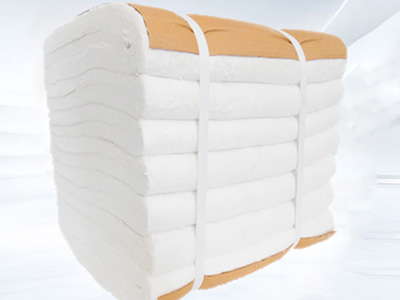Ceramic fiber modules for brick kiln insulation. Ceramic fiber modules are also called aluminum silicate fiber modules, refractory fiber modules, and refractory insulation cotton blocks. In order to simplify and speed up kiln construction and improve the integrity of furnace lining, new refractory lining products that can replace traditional heavy refractory materials have been introduced, which has promoted the progress of kiln masonry technology. RS Kiln Refractory manufactures high-quality ceramic fiber modules for the insulation of industrial furnace linings. At the same time, our new inorganic heat insulation board products can also be used in the insulation layer of industrial furnaces. Good heat preservation effect, and at the same time can effectively reduce the weight of industrial furnace lining.

Features of ceramic fiber modules for brick kiln insulation
Ceramic fiber modules have excellent chemical stability, excellent thermal stability, and excellent elasticity. The module is in a pre-compressed state. After the furnace lining is built, the expansion of the module makes the furnace lining seamless and can compensate for the shrinkage of the fiber furnace lining. In order to improve the thermal insulation performance of the fiber furnace lining, the overall performance is good. Excellent thermal stability and thermal shock resistance. Ceramic fiber modules (aluminum silicate fiber modules, refractory fiber modules) are installed quickly. In addition, the anchor is arranged on the cold surface of the wall lining, which can reduce the requirements for the material of the anchor. The RS Kiln Refractory manufacturer can design the insulation layer material according to the different furnace types of customers.
Advantages of Ceramic Fiber Module Lining
Ceramic fiber modular furnace lining, as a light and efficient thermal insulation furnace lining, has the following technical performance advantages compared with traditional refractory material furnace linings.
(1) Low bulk density. Ceramic fiber modular furnace lining is more than 70% lighter than the lightweight insulating brick lining, and 75% to 80% lighter than the lightweight castable lining. It can greatly reduce the steel structure load of the kiln and prolong the service life of the furnace body.
(2) Low heat capacity. The heat capacity of the furnace lining material is generally proportional to the weight of the furnace lining. Low heat capacity means that the kiln absorbs less heat during reciprocating operation, and at the same time, the temperature rises faster. The thermal capacity of ceramic fiber is only 1/7 of that of lightweight heat-resistant lining and lightweight clay ceramic tiles. The energy consumption in the furnace temperature operation control is greatly reduced, especially for intermittently operated heating furnaces, which can have a very significant energy-saving effect.
(3) Low thermal conductivity. When the average temperature of the ceramic fiber module is 400°C, the thermal conductivity is less than 0.11W/(m·K). At an average temperature of 600°C, the thermal conductivity is less than 0.22W/(m·K). At an average temperature of 1000°C, the thermal conductivity is less than 0.28W/(m·K). It is about 1/8 of the lightweight clay brick and 1/10 of the lightweight heat-resistant lining (castable) and has a remarkable thermal insulation effect.
(4) Excellent thermal shock and mechanical vibration resistance. The ceramic fiber module is flexible and has particularly good resistance to severe temperature fluctuations and mechanical vibrations.
(5) The construction is simple. Its special anchoring method solves the problem of slow installation speed of traditional modules. The folding modules press against each other in different directions after unbundling without gaps. The furnace lining does not need to be dried and maintained and can be used directly after installation.
At present, energy saving, environmental protection, and prevention of global warming have increasingly become the focus of attention of countries all over the world. Fuel costs will become a bottleneck for the development of the steel industry. Therefore, people are more and more concerned about the heat loss of industrial furnaces. According to statistics, after using ceramic fiber modules in the refractory lining of general continuous industrial furnaces, the energy-saving rate is 3% to 10%. The energy-saving rate of batch furnaces and thermal equipment can reach 10% to 30%, or even higher. The use of ceramic fiber module lining can prolong the life of the furnace and reduce the heat loss of the furnace body. The application of a new generation of crystalline ceramic fiber composite modules can not only improve the cleanliness of the furnace, and improve product quality, but also achieve a better energy-saving effect. Therefore, industrial furnaces, especially heating furnaces in the iron and steel industry, should be designed with ceramic fiber modules as the furnace lining as much as possible. The old heating furnace should make the best use of the maintenance time, and change the refractory brick or layer carpet lining to the ceramic fiber module structure. This is also an important measure to realize the sustainable development of the steel industry.
RS Kiln Refractory Manufacturers
High-efficiency kiln insulation will greatly reduce the fuel consumption of industrial furnaces and improve the utilization rate of heat energy. RS Kiln Refractory manufacturers aim to provide high-quality refractory services for high-temperature industrial furnaces. Whether it is the design and construction of refractory materials for the working layer of industrial furnace lining or the solution for refractory materials for the insulation layer. We will provide you with the most suitable refractory products for your production needs on the premise of directly saving costs.